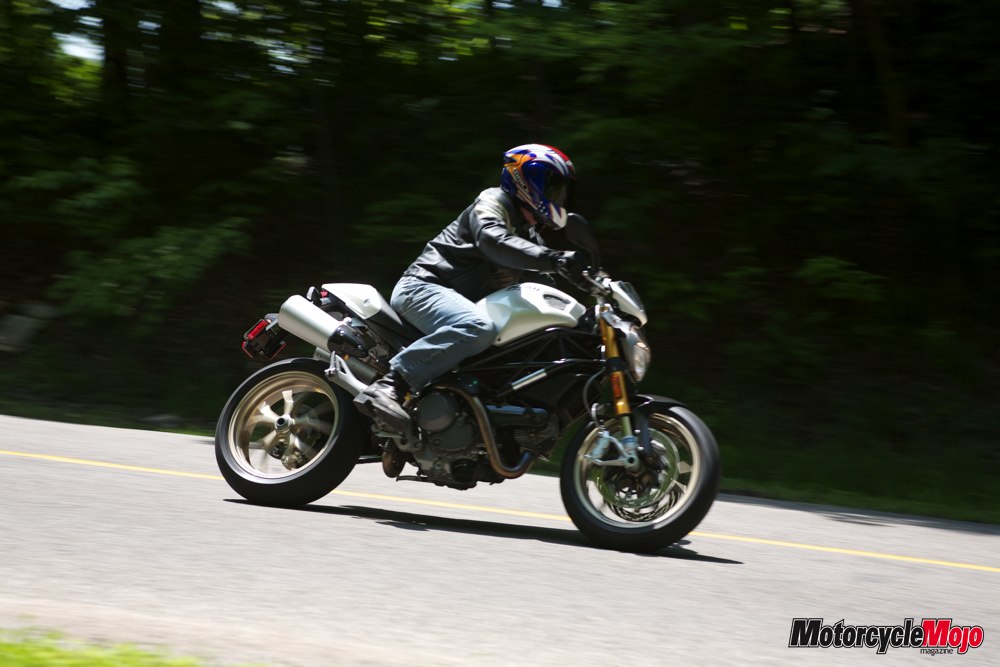Hot on the heals of the highly successful revamp of Ducati’s smallest Monster, the 696, comes the similarly remodeled and displacement improved Monster 1100 and 1100S (replacing the S2R 1000).
Last summer I thoroughly enjoyed my time with the 696 and found it to be a terrific bike for knocking around town, hitting curvy roads, or even open road travel. I appreciated the ergonomics as well as the excellent fuel economy and range which gave me plenty of time to enjoy the surprisingly comfy saddle. I didn’t find the wee Monster to be wanting for power, but I found thoughts of an extra 15 hp and a whopping 25 lb-ft increase in torque offered by the 1078 cc version to be stimulating.
At first viewing, the big Monster shares the look of its handsome little brother, but a closer look reveals substantial upgrades including a very tasty single-sided swingarm, new ‘Y’ shaped 5-spoke wheels with a wider rear allowing fitment of 180 mm tire vs. the 160 of the 696, and attractive tapered handlebars replace the tubular unit of the 696. My test unit was the premium ‘S’ model that features Ohlins fork and shock components to handle suspension duties, rather than the Showa fork and Sachs shock components of the base 1100 Monster.
Other less obvious changes for the ‘S’ model from the 696 include a modest weight gain of 7 kg (15 lb) to a still svelte 168 kg (370 lb, claimed dry), a slightly higher seat at 81 cm (31.9 in) from 77 cm and implementation of a dry clutch on the 1100S instead of the 696’s wet clutch.
Riding the Monster 1100 brought back memories of the many things I liked about the more ‘budget-minded’ Ducati offering. Easy handling and light weight are attributes common to both little and big Monster, but the additional and easy to access grunt from the big motor make for a more lively ride. The surprisingly rich sound from the 696’s stock mufflers received many compliments, and if anything, the 1100’s tune proved to be even more satisfying and deeper sounding.
Braking duties are handled by the same excellent system employed by the 696. Dual 320 mm discs pinched by radial mounted 4-piston calipers in front and 245 mm disc with a 2-piston caliper out back offer superb power and feel in all conditions encountered.
Available power is substantial, even down low but the Duc is happiest when kept above 2500-rpm, in particular from third gear on up. Clutch pull is reasonably light but the narrow engagement range can make for abrupt power delivery most noticeable in the lower two gears. The balancing act gets a bit more delicate if pulling away with a cold engine. In these instances, one can expect some popping and farting and ensuing feathering of the clutch till adequately warmed, generally a minute or two later. If the rider is so inclined, the combination of stout power and light weight will see the front tire part company with the ground with surprising ease, especially in the lower gears.
Cruising along comfortably at 125 km/h sees the LCD segmented tach indicating a relaxed 4,000-rpm. With maximum power arriving at 7,500-rpm, this obviously isn’t a rev crazy motor in the vein of a 4-cylinder sport bike, but rather offers flexible real world power delivery. Normal expectation would be that the substantial increase in displacement and power would take a toll on fuel consumption. Not so in this case as the big Monster is almost as efficient as its little brother delivering an excellent 4.35 L/100 km (65 mpg) through all kinds of riding. The 696’s fuel consumption was 4.2 L/100 km (67mpg). Range from its 15-litre tank is a long legged 345 km if one feels lucky.
So with all the extra goodies and power, is the big Monster better than the little Monster? With the excellent, but ’budget-priced’ 696 coming in at $9,995 and the 1100 weighing in at $13,995 ($2,000 more for the premium ‘S’ model) you will have to let your wallet decide.










